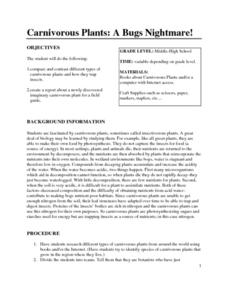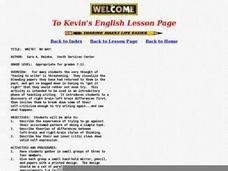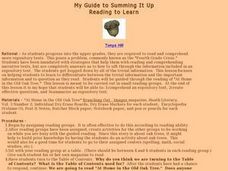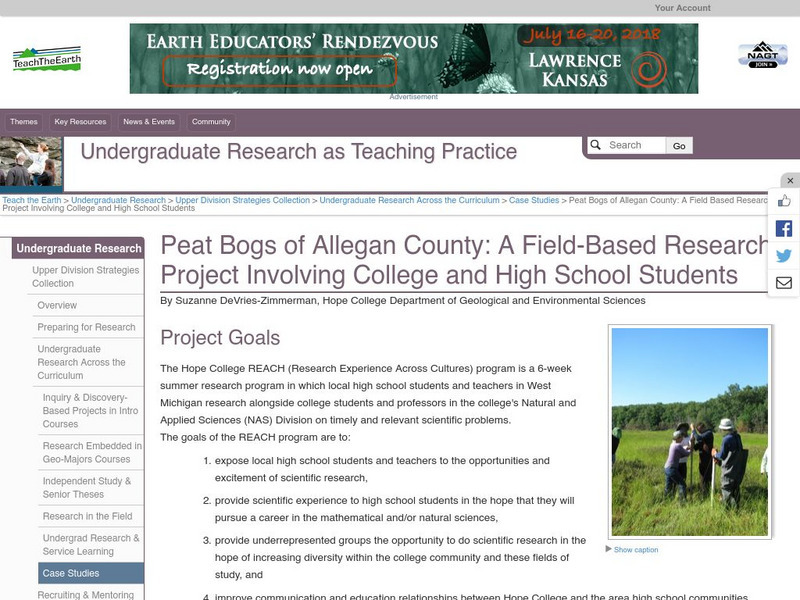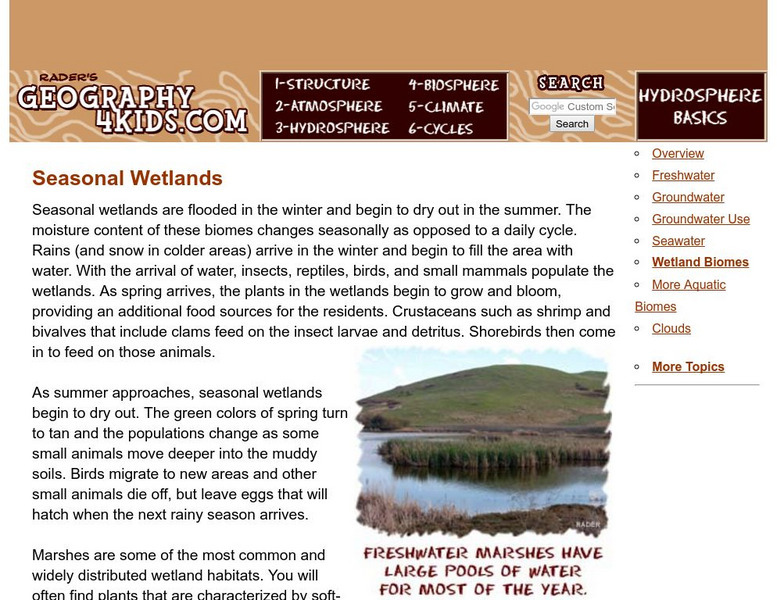Curated OER
pH Potential
Students experiment to determine the positive and negative impacts of human activities on environmental change. They examine how physical and biological processes such as decomposition affect soil characteristics while looking at the pH...
Curated OER
Carnivorous Plants: A Bugs Nightmare!
Students research carnivorous plants and how they trap insects. They role play as botanists to write a research field guide about a newly discovered imaginary carnivorous plant.
Curated OER
WRITE? NO WAY!
Students discover the right brain-left brain differences and then think about how to break down some of their self-criticism to try writing.
Curated OER
Cloud Types and Formation of Clouds
Students take cloud and weather related photographs during the year, making certain to make notes of when, where and what time the photograph was taken. At some point all the pictures be gathered and a scrapbook or "cloud library" be made.
Curated OER
Aquatic Communities
Students watch a video about aquatic communities. They conduct an experiment that shows how movement of rivers change the landscape. They compare fresh and salt water communities and its wildlife.
Curated OER
Mini-Ecosystems
Students use plastic bottles to create terrariums and plant Venus Flytraps. They observe the plants and the terrariums for illustrations of the water cycle and species' adaptations to a specific environment.
Curated OER
Controlled Narrative Writing
Learners examine a short story and add possible adjectives. They re-read the story and add adverbs. They also add other information to make the story interesting.
Curated OER
Wetland Wonders
Young scholars describe the characteristics of wetlands. They demonstrate their understanding of the importance of wetlands to humans and wildlife and determine they are defined by the presence of water, and specialized soils.
Curated OER
My Guide to Summing It Up
Students are broken into reading groups based on reading ability and rotate one group at a time reading with the teacher at a table. They discuss the function of the Table of Contents and find a story using it and predict what the story...
Curated OER
Addition Review
Students explore the concept of addition as used in the subject of Algebra while reviewing the different methods using a number line. The lesson plan includes examples for students to use for scaffolding for group work or whole class...
Curated OER
Living Water
Pupils read an ancient Asian fairy tale. While visiting a local park, they collect both male and female seeds found in cones. They identify the type of trees they found the cones by and discuss what they are used for. In groups, they...
Curated OER
Word Lists for Group Two- Spelling Patterns- r, l, d, b, f, h, i, u
In this phonics and spelling worksheet, students examine word lists that contain common spelling patterns including: CVC, VCC, CVCC, CCVC, CCVCC.
Archaeological Institute of America
Archaeology: Bodies of the Bogs
Human sacrifices, unlucky people, victims of violence? What are the stories of the bog bodies? This article contains research on these bodies as well as many pictures of specimens.
Science Education Resource Center at Carleton College
Serc: Peat Bogs of Allegan County: A Field Based Research Project
An article describing a research project where students and teachers spent six weeks during the summer investigating bogs. Learn more about the program in general as well as what teachers and students discovered during their research.
Cornell Lab of Ornithology
Habitat Network: Bog Wetlands
Find out why bogs are one of the most unique and fascinating types of wetlands in North America.
US Environmental Protection Agency
Epa: Secret of Bog Creek
This site has a user guided story about a bog that has been a secret dumping ground for waste.
EL Education
El Education: What's Happening in the Bog?
An online book entitled What's Happening in the Bog by 6th graders at Duggan Middle School in Springfield, Massachusetts. The book contains descriptions and photographs and illustrations of plants and animals found in Duggan Leatherleaf...
Friends of Algonquin Park
The Science Behind Algonquin's Animals: Spruce Bogs
A Spruce bog is a northern type of habitat and is formed between small bodies of water and forests. Learn about a Spruce bog in Algonquin part and view a panorama movie of the bog.
Friends of Algonquin Park
The Science Behind Algonquin's Animals: Spruce Bog Panorama
View a panorama movie of a Spruce Bog in Algonquin Provincial Park.
Smithsonian Institution
National Museum of Natural History: American Mammals: Southern Bog Lemming
Southern Bog Lemmings are born with whiskers and a scattering of hairs on their heads and backs. They are well-furred when they are a week old, and look like miniature adults at two weeks of age. Learn more about the Synaptomys cooperi,...
Smithsonian Institution
National Museum of Natural History: American Mammals: Northern Bog Lemming
Northern Bog Lemmings have a large geographic range, but they are seldom encountered, and the reason for their apparent scarcity is not known. Their preferred foods - sedges and grasses - are abundant, and they do not have very limiting...
EL Education
El Education: A Field Guide to East Bog Swamp
This micro-field guide was created by 5th and 6th graders in Marlboro, Vermont. Groups of 3 or 4 students worked together to investigate their own 3 by 3 foot research plot, over multiple visits, and then created a field guide to their...
Geography 4 kids
Geography4 kids.com: Seasonal Wetlands
Identify the four types of seasonal wetlands found across the earth. There are fresh water and salt water marshes, bogs, and swamps.
Ducksters
Ducksters: Science for Kids: Freshwater Biome
Kids learn about the freshwater aquatic biome. Ecosystems such as rivers, streams, ponds, lakes, wetlands, swamps, and bogs.
Other popular searches
- Bog Mummies
- Bog Bodies
- Media Education Bogging
- Cranberry Bog
- Bog Land
- Bog Ecology
- Bog Communities
- Bog Simulation
- Bog Turtle
- Bog Bodies Lindow Man
- Afro in the Bog
- Bog Turtle Niche

